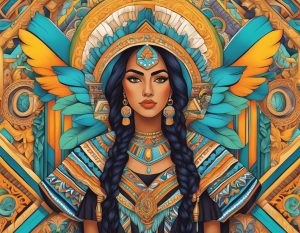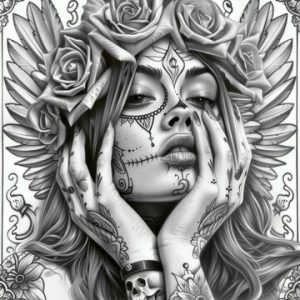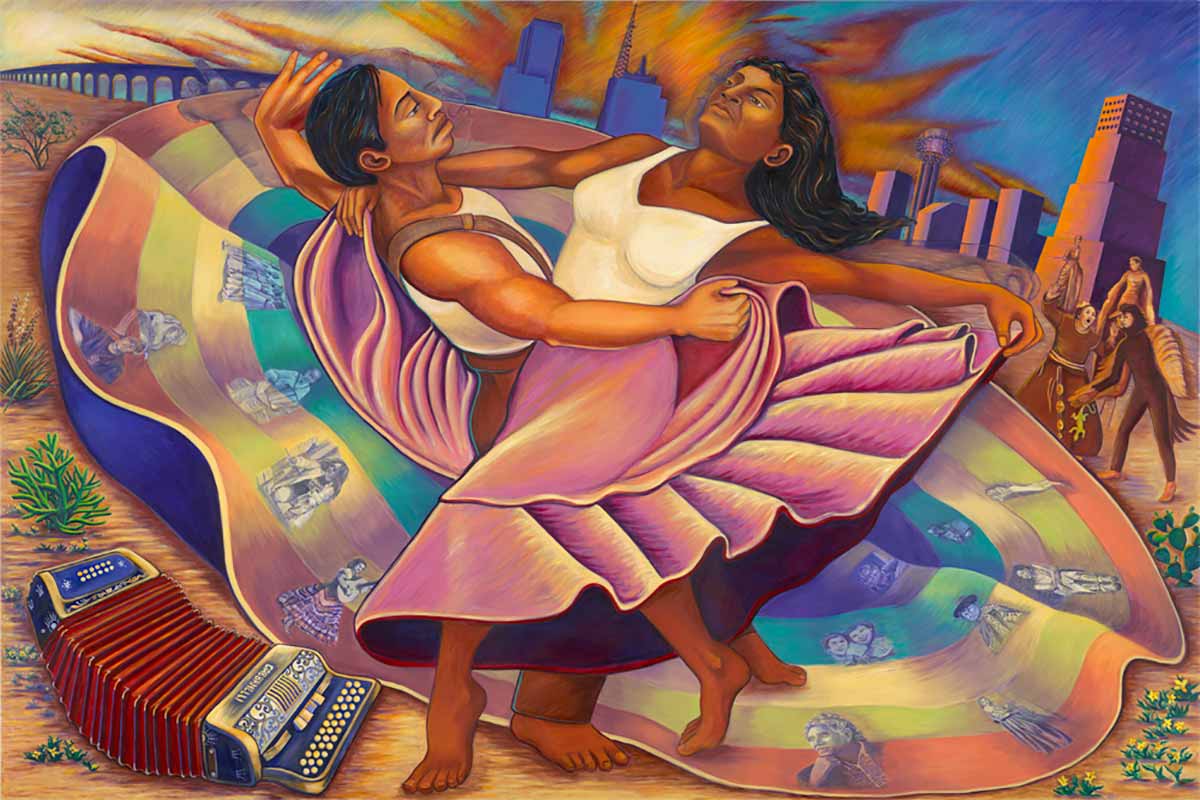The art form known as “Chicano art” has its roots in the American Chicano population, especially in the Southwest. Its use of vivid colors, strong lines, and cultural symbols and themes that capture the essence of the Chicano experience and identity are what define it. Both American pop culture and traditional Mexican culture and the arts are frequently included in Chicano art.
Chicano art: what is it?
- Chicano art can employ a wide range of methods and aesthetics, such as graffiti, murals, tattoos, and drawings. A multitude of mediums, such as paints, markers, which means colored pencils, and ink, can be used to make Chicano art
- Chicano art frequently explores topics and subjects related to political and social problems, cultural customs, family and community, and individual identity. In addition to celebrating and honoring their cultural history, Chicano artists frequently utilize their art to share their experiences and viewpoints as participants in the Chicano community.
- Chicano art is a potent means of artistic expression that has been integral to Chicano culture for a long time and was crucial to the Chicano human rights movement. Numerous Chicano artists utilize their work to bring attention to problems that affect the Chicano population, like immigration reform, police brutality, and discrimination.
- Chicano art is a rich and colorful cultural expression that honors the diversity and inventiveness of the Chicano population along with its political and social significance. Chicano artists frequently include Day of the Dead images, religious emblems, Aztec and Maya symbols, and other aspects of conventional Mexican art and culture in their works.
There are plenty of materials available to assist you in getting started if you’re interested in making Chicano art drawings. In addition to online courses and workshops that teach various Chicano art techniques and styles, you will discover inspiration and direction from other Chicano artists. When creating art, constantly keep in mind to take your time, enjoy yourself, and don’t be scared to try new things and explore.
CHARACTERISTICS OF CHICANO ART

Bright, bold colors are frequently employed in Chicano art to produce a powerful visual impression and elicit strong emotions, making them one of the genre’s defining characteristics. Strong, thick lines are another common technique used by Chicano painters to convey movement and vigor in their works.
Chicano art frequently combines elements of American popular culture, including music, television, and film, with traditional Mexican and Chicano cultural themes. To produce distinctive and dynamic works of art, Chicano artists may also find inspiration in other artistic Mediums, such as comic books, tattoos, and graffiti.
There are many different types of Chicano art, including paintings, murals, tattoos, and drawings. In addition, sculptures, installations, and other three-dimensional pieces of art can be produced by Chicano artists.
Making The Revolution Print! Chicano Graphics’ Ascent And Influence From 1965 Until The Present
Activist Chicano artists created a great history of printmaking in the 1960s that is still important today. During the civil rights, labor, anti-war, feminist, and LGBTQ+ movements, many artists came of age. They channeled the social activism of the time into bold aesthetic declarations that heralded an innovative political and cultural consciousness among Americans of Mexican origin. ¡Printing the Revolution! delves at the emergence of Chicano graphics in these pioneering social movements and how Chicanx artists have progressed inventive printmaking techniques sensitive to social justice in the years afterward.
The artwork in this show does more than only highlight the requirement for social change; it also challenges preconceived ideas about Chicanx identity, inspires political action, and gives visitors fresh perspectives on both American and global history. Through a variety of visual and artistic approaches, including conceptualism, politicized pop, appropriation, satire, and portraiture, the artists in this presentation create an innovative and long-lasting graphic heritage that has not yet been fully assimilated into the past four centuries of American printmaking.
Step By Step Guidelines For Doing Chicano Art Drawing

- Using a light pencil, begin by drafting the drawing’s outline. This will make it simple for you to make adjustments and modifications
- Add your drawing’s fundamental forms and shapes, such as triangles, squares, and circles, next. These shapes will assist you in establishing the composition and scale of your artwork
- Start including aspects and components, such as text, patterns, and symbols, that are unique to Chicano art drawings. These can draw inspiration from religious symbols, Day of the Dead images, or Chicano political movements, among other aspects of traditional Chicano culture.
- After finishing the drawing’s basic composition and details, go over your lines with a pen or marker to get a more polished and finished piece.
- Lastly, you can use paints, markers, or colored pencils to add color to your image. Vibrant, strong colors may give your drawing depth and a powerful visual impact.
Don’t forget to enjoy yourself and take your time while drawing. Additionally, you can hunt for reference photos or examples of Chicano art to assist you generate ideas and inspiration for your paintings.
The History, Cultural Allusions, and Artists of Chicano Art Tattoos
The Origins of Chicano Tattooing in History
Grey hues with a smooth texture draw attention to the Chicano tattoo movement’s emphasis on illustration. It makes sense that the artworks’ artistic fusion of pencil and ballpoint pen drawings with an extraordinarily rich cultural context occurs from their origins. Though Frida Kahlo and Diego Rivera are among the most well-known artists, other prominent Mexican artists included Jesus Helguera, María Izquierdo, and David Alfaro Siqueiros. Together with other South American artists, they primarily portrayed families, everyday life, and political unrest in their works. Even while these pieces may appear to be very different from contemporary Chicano tattoo art, literal studies and illustrative techniques that combine surrealism and realism help to explain why much of today’s Chicano art has the distinct style that it has.
The Cultural Allusions in Hispanic Body Art
Much of the tattoo art associated with Chicano culture feels so intimate because it is. Rife racism, classism, and inequality drove migrants who had worked their way up from Mexico to sections of Texas and California to the periphery of society. Although the migrating community experienced great hardship as a result, this also meant that their customs were protected and largely conserved over the years. Many Chicano youngsters rebelled against the established quo during the 1920s–1940s migration peak. The death of a young Latino man in Los Angeles served as the catalyst for the eventual culmination of this in 1943—the Zoot Suit Riots. Although it might not seem significant given the history of Chicano tattoo art, this was not the first or the last instance of cultural expression being repressed. The truth is that a large portion of this dispute resulted in arrests, which were frequently the result of xenophobic social pressure on migrant populations. Unquestionably, this political shift had a direct impact on Chicano aesthetics.
Chicano Tattoo Artists In The Field Of Tattooing
Numerous tattoo artists who specialize in Chicano tattooing are also members of the Chicano culture. A significant factor that hinders appropriation is the preservation and observance of a legacy; without an authentic understanding and a personal connection, it might be impossible to recreate visuals. Nonetheless, the designs have been a huge part of tattoo history for so long that many artists have perfected the style and contributed to the preservation and propagation of this vital aspect of tattoo culture.
Modern Chicano tattooing is led by Chuco Moreno, Freddy Negrete, Chuey Quintanar, and Tamara Santibañez. Each artist can add a unique touch to stylistic iconography while still working within its boundaries, just like in any other artistic movement. Chicano tattoo style combines many elements of tattooing culture in a stunning array of techniques and images, ranging from black and gray realism to graphite-like artistic and even Chicano-impacted American Traditional. Jose Araujo Martinez, Javier DeLuna, Jason Ochoa, Freddy Negret, Mister Cartoon, El Whyner, Panchos Placas, and El Whyner are some other artists with well-defined personal styles. Every one of these tattoo artists appreciates their own culture and experience, even though many of them don’t adhere rigidly to one particular style. Their highly regarded work reflects it.
Chicano Art’s Future
From the 1960s till now, the Chicano Art Movement has undergone significant growth. The movement, which upheld Mexican Americans’ cultural identity and social status, has played a significant role in American history. Academics have observed that Chicano art has played a significant role in drawing attention to the problems that the community faces, including prejudice, social injustice, and cultural oppression.
Chicano art appears to have a bright future as long as numerous young artists continue to produce works that capture the spirit and hardships of the community. A dynamic and diversified art community has resulted from the movement’s expansion beyond its initial focus on the barrio, which today encompasses artists from across the nation.
Chicano art will probably become even more ingrained in the canon of American art history as the movement develops. Not only will this integration provide Chicano artists more visibility, but it will also contribute to a wider exchange of cultural ideas and understanding across various cultures.
In general, the movement’s ability to motivate and inspire artists to produce works that capture the distinct experiences and viewpoints of the community bodes well for the future of Chicano art.

